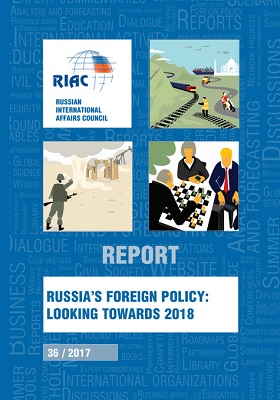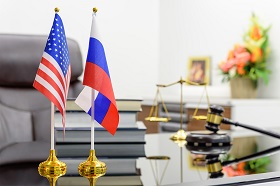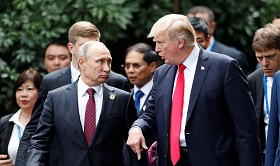How does the world in 2018 look from the Kremlin? Judging from statements and interviews of Russian leaders, the world is not a very cool place these days. The international environment is more adversarial than cooperative; security challenges dominate over development opportunities; national survival rather than economic prosperity is the name of the game in global politics. The Kremlin’s perspective implies that the international system has entered an arguably long period of instability, increased volatilities, multiple regional crises and, more generally, a steep decline of the global and regional governance.
In my view, it would be wrong to dismiss this vision of the world as completely hypocritical or entirely self-serving; it reflects very real concerns and fears of the Russian leadership. Let me try to summarize the most often referred to manifestations of the 2018 international ill-beings, perceived roots of the problems and Kremlin’s suggestions on how to deal with multifaceted crises in 2018 and beyond.
How does the world in 2018 look from the Kremlin? Judging from statements and interviews of Russian leaders, the world is not a very cool place these days. The international environment is more adversarial than cooperative; security challenges dominate over development opportunities; national survival rather than economic prosperity is the name of the game in global politics. The Kremlin’s perspective implies that the international system has entered an arguably long period of instability, increased volatilities, multiple regional crises and, more generally, a steep decline of the global and regional governance.
In my view, it would be wrong to dismiss this vision of the world as completely hypocritical or entirely self-serving; it reflects very real concerns and fears of the Russian leadership. Let me try to summarize the most often referred to manifestations of the 2018 international ill-beings, perceived roots of the problems and Kremlin’s suggestions on how to deal with multifaceted crises in 2018 and beyond.
Manifestations:
- The state crisis in the MENA region, in sub-Saharan Africa, in parts of the former Soviet Union. States are losing their sovereignty; they cannot provide law, order or basis social services to populations on their territories, turning into failed or semi-failed states. Failed states became hotbeds of conflicts that last for years and even decades with no solutions in sight.
- The growing unpredictability and volatility of global and regional economic and financial markets creates new risks; states, societies and individuals can no longer control their economic destinies or even to influence them in a significant way. We observe economic and social polarization among states and within them; polarization increases populism, radicalism and extremism of various kinds.
- The rise of non-state actors challenges state sovereignty and questions the fundamentals of the modern international system. Irresponsible non-state players (from international terrorism and religious fundamentalism to transnational crime and multinational corporations) are accountable to nobody and often have goals and aspirations incompatible with international peace, stability and prosperity. Any attempts to manipulate these players are counterproductive and dangerous.
- Uncontrolled and potentially disastrous environmental and climate changes, mounting challenges to biodiversity, environmental stability and resource sufficiency constitute another dimension to the crisis. We observe gross inequalities in resource distribution around the world, the looming resource crunch (food, energy, fresh water, etc.).
- The explosion of regional, continental and global migrations increasingly affect the world, which is completely unprepared to confront this challenge. It leads to an unavoidable economic, political, security, social and cultural implications of the coming migration crisis with most countries ill equipped to handle these implications.
- Another manifestation of the crisis is the ongoing decline of many international institutions — global and regional, security and economic alike; the growing inability of the UN based system to find effective solutions to mounting problems. In many cases, we witness a shift from legitimate institutions to illegitimate or semi-legitimate ad hoc coalitions.
Roots:
- The liberal economic and political paradigms have depleted their potential; they can no longer provide a stable economic growth, a fair distribution of wealth and an acceptable political inclusiveness. Spontaneous market forces and open political competition demonstrate their limitations.
- The Western triumphalism after the end of the Cold War led to an institutional overstretch and to ungrounded hopes for the West-centered world. The Western (both American and European) arrogance led to many crises that could otherwise have been avoided or at least mitigated.
- The selective use of international law, double standards in international relations, a lot of hypocrisy and double-speak contributed to the erosion of some of the fundamental norms of international public law. These factors produced diverging and even opposite narratives, contributed to more cynicism, opportunism and transnationalism in foreign policies.
- The rapid and chaotic process of globalization produced many negative side effects including a rapid decline of traditional values, a global revolution of expectations along with social and cultural polarization, growing vulnerability of an individual to extremism and political radicalism.
- The ongoing technological revolution created a whole spectrum of new opportunities for disruptive and subversive non-state actors — including new means of communications, new types of weapons, and new mechanisms of political mobilization. However, states turned out to be unprepared to regulate properly the technological revolution and to put its potentially dangerous repercussions under proper control.
- Most of the Western political systems do not allow for any long term planning; politicians in the West are looking for fast results and quick returns on their political investments. This feature of the modern liberal democracy contradicts the apparent need for large scale and long term political projects, including resource-consuming ones.
Solutions:
- We have to agree that the critical task of the day is the task to restore and to enhance the shattered global management. Without addressing this task, we are not going to succeed in any other undertakings. The central dividing line in the modern international system is not that between democracy and tyranny, but between order and chaos.
- The prime building blocks of the international system are and will continue to be nation states. Therefore, the principle of sovereignty should be fully adhered to and considered to be of paramount importance. Interdependence and integration can be accepted as long as they do not contradict the principle of sovereignty.
- The emerging international system should fully reflect the changing balance of powers in the world. The existing West-centered institutions should either undergo a profound transformation or be replaced by more universal, more inclusive and more representative organizations.
- We should fully reject the concept of Western (i.e. liberal) universalism of favor of developmental pluralism. The emerging concept of modernity should imply opportunities for preserving national traditions, culture, specific economic, social and cultural models distinctly different from the Western examples. No export of liberal democracy should be supported or even tolerated.
- Spontaneous market mechanisms, which set the rules for the global economic and financial systems today, should be complemented by appropriate regulatory frameworks; these are to be agreed upon by participating states. Non-state actors should be forces to moderate their ambitions and behave accordingly.
- The overall international system should constitute a pyramid with a number of interacting levels: (1) UN and its specialized agencies; (2) regional security and development institutions; (3) ad-hoc coalitions and alliances with an appropriate mandate; (4) a system of overlapping multilateral and bilateral agreements and other arrangements (regimes), and (5) a think network of contacts, interactions, partnerships, etc. of non-sate, sub-national and other actors.
Numerous critics of Vladimir Putin in the West would argue that this picture of the world in 2018 is one-sided, dogmatic, antiquated and misleading. They would also insist that Russia itself contributed a lot to many problems that the international community has to deal with in 2018 and beyond. Finally, they are likely to maintain that this vision is meant to justify the current Russia’s foreign policy and security posture, to keep the Russian political system intact and to put on a back burner all the badly needed economic and social reforms.
However, a more productive approach might be in trying to single out particular bits and pieces of this vision, which could constitute a basis for a substantive, albeit very limited, dialogue between Russia and the West on the fundamentals of the emerging world order. Even if this dialogue in any format starts this year, it is unlikely bear fruits anytime soon. Nevertheless, to understand Russia’s true concerns, fears, perceptions and expectations remains important, no matter how archaic, biased, opinionated or self-serving these might appear in the eyes of Russia’s critics.
Nikolai Lobachevski teaches us that two parallel lines can intersect, if we move away from the traditional Euclidean to a non-Euclidean geometry. Regardless of how each of us sees the world in 2018, it seems apparent that this world can no longer be explained within traditional IR paradigms. Once we shift to a non-Euclidean approach, parallel visions of the international system may gradually get closer to each other and finally intersect.







